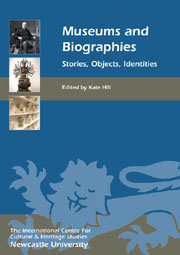Book contents
- Frontmatter
- Contents
- List of Illustrations
- Introduction: Museums and Biographies – Telling Stories about People, Things and Relationships
- INDIVIDUAL BIOGRAPHY AND MUSEUM HISTORY
- PROBLEMATISING INDIVIDUALS' BIOGRAPHIES
- INSTITUTIONAL BIOGRAPHIES
- OBJECT BIOGRAPHIES
- MUSEUMS AS BIOGRAPHY
- 16 Houses and Things: Literary House Museums as Collective Biography
- 17 ‘Keepers of the Flame’: Biography, Science and Personality in the Museum
- 18 National History as Biography: Alexandre Lenoir's Museum of French Monuments
- MUSEUMS AS AUTOBIOGRAPHY
- Endpiece: The Homunculus and the Pantograph, or Narcissus at the Met
- List of Contributors
- Index
17 - ‘Keepers of the Flame’: Biography, Science and Personality in the Museum
from MUSEUMS AS BIOGRAPHY
Published online by Cambridge University Press: 05 February 2013
- Frontmatter
- Contents
- List of Illustrations
- Introduction: Museums and Biographies – Telling Stories about People, Things and Relationships
- INDIVIDUAL BIOGRAPHY AND MUSEUM HISTORY
- PROBLEMATISING INDIVIDUALS' BIOGRAPHIES
- INSTITUTIONAL BIOGRAPHIES
- OBJECT BIOGRAPHIES
- MUSEUMS AS BIOGRAPHY
- 16 Houses and Things: Literary House Museums as Collective Biography
- 17 ‘Keepers of the Flame’: Biography, Science and Personality in the Museum
- 18 National History as Biography: Alexandre Lenoir's Museum of French Monuments
- MUSEUMS AS AUTOBIOGRAPHY
- Endpiece: The Homunculus and the Pantograph, or Narcissus at the Met
- List of Contributors
- Index
Summary
INTRODUCTION
In 1854 Charles Dickens visited Paris, the scene of one of his most famous novels, A Tale of Two Cities (1859), and found inspiration in what he termed the museum of ‘Second-Hand Sovereigns’. There, in the Louvre, he found a museum of the ‘Paraphernalia of the Kings and Emperors of France’, and, despite railing against the rottenness of human grandeur, he was carried away by seeing the boots, the hats, the voluminous crimson mantle, the Emperor's writing-table which bore ‘oh! such unmistakeable signs of hard work, indomitable perseverance, and iron will! … splashed with ink … punched with penknives … scorched with sealing wax …’ Indeed he was ‘so saturated with notions of the Empire’ as to be veritably transported in time. Hearing a pair of boots creak next door, he almost expected to see Duroc, Bertrand, or Rapp come in and ask ‘Que diable?’ What am I doing here? And out of the lofty windows the illusion continued, he could ‘see on parade’ the Imperial Guard, and it only wanted to complete the picture a distant roll of drums, a sharp rattle of arms presented, ‘and then, cantering into the square upon a white horse, a little man with a cocked hat and a grey great coat’ (Dickens 1855, 511–16).
Dickens' imagination was one which ranged more powerfully and creatively than most and there is a nice tension between the scornful reference to Second-Hand Sovereigns and his actual response to the objects on display.
- Type
- Chapter
- Information
- Museums and BiographiesStories, Objects, Identities, pp. 247 - 264Publisher: Boydell & BrewerPrint publication year: 2012

